June 8th, 2014 §
The two little pullets that hatched in March are twelve weeks old today. I know it’s poor judgement on my part, especially given a day-time fox sighting at the back of the property last week, but I have grown rather fond of them. They are incredibly cute, and are more tame than any of the other chickens I have raised. They are still small enough that I can easily hold both in one hand. They think nothing of half-flying, half-running all the way across the unknown lawn toward me when they feel threatened. Adorable.
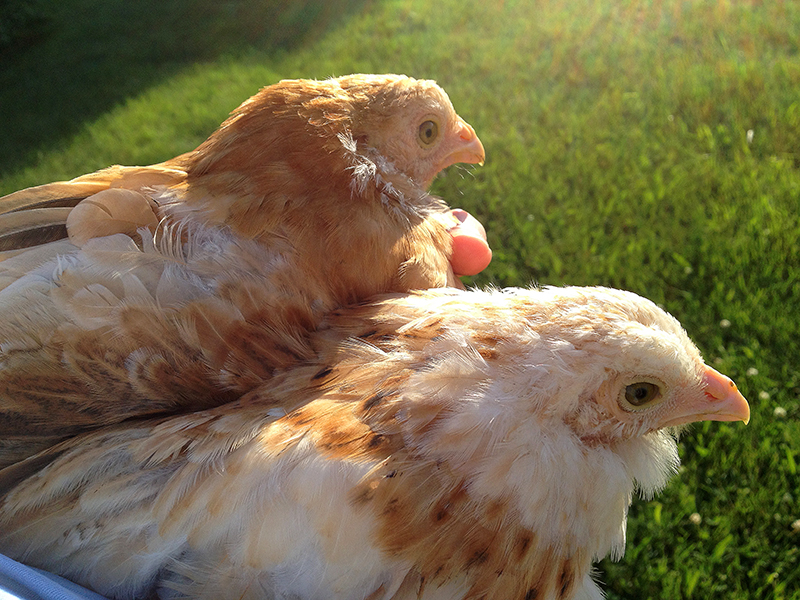
A couple of weeks ago, when I finally got their injured broody mother reintegrated into the main flock, I moved the chicks from their broody coop in the garage into a big dog crate in the main coop, where they have their own food and water. They are getting used to being with the main flock while still being protected from attacks. I have also started letting them free range a little, turning them loose in the front garden while I am outside. They’ve met the larger birds during their rambles, and of course were chased and pecked back (but not injured) into hiding places in the bushes.

They discovered dust bathing the other day. The hilarious thing was that despite having access to a whole garden of soft soil, they chose to bathe right on top of one another, kicking each other in the heads as they burrowed into this new experience.
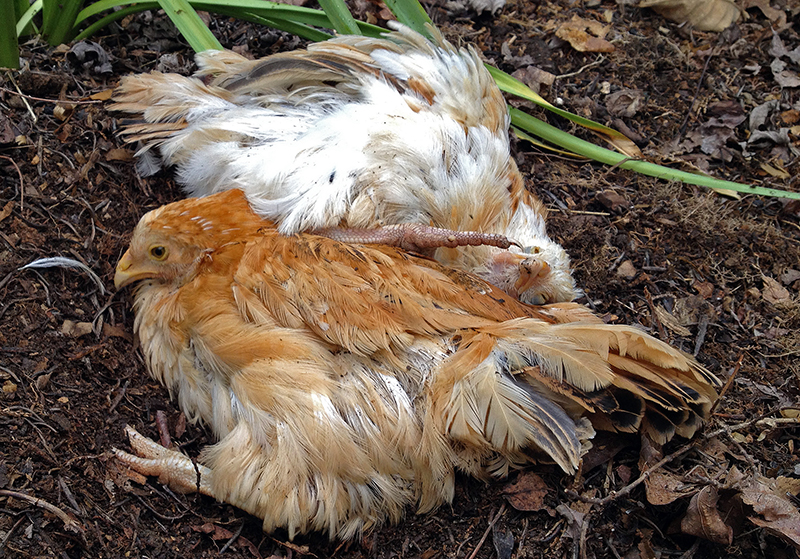
It’s neat to watch the chicks explore their world. They are in many ways like kids and baby animals everywhere—a mixture of boldness and trepidation.

Against my better judgement of growing too attached to animals that could at any moment meet their ends in a number of horrible ways, I have named them Buttercup and Clover.
May 12th, 2014 §
Last week most of my car trips included a chirping cardboard box riding shotgun. I delivered the chicks, which hatched in March, to their new owners. The little black pullet went to an acquaintance, a Wheaten Ameraucana pullet found a new and loving home with one of my Master Gardener friends, and the four Wheaten Ameraucana cockerels sold on CraigsList within an hour. Isn’t he handsome?

I kept two pullets. One is a pure Wheaten Ameraucana (in front below) and the other is a mystery hatched from a green egg out of a black mother! I love chickens at this age—about ten weeks—because they are sweet and curious, fully feathered but still small enough to pick up with one hand. They’re like little mini chicken pocket pets.
During the day I take the pullets out of their broody coop in the garage and put them in Tucker’s old puppy crate on the grass, and they eat their fill of clover, chickweed, whatever unfortunate bug comes along, and any grubs I unearth while digging in the garden. Last night they got to try pear for the first time.
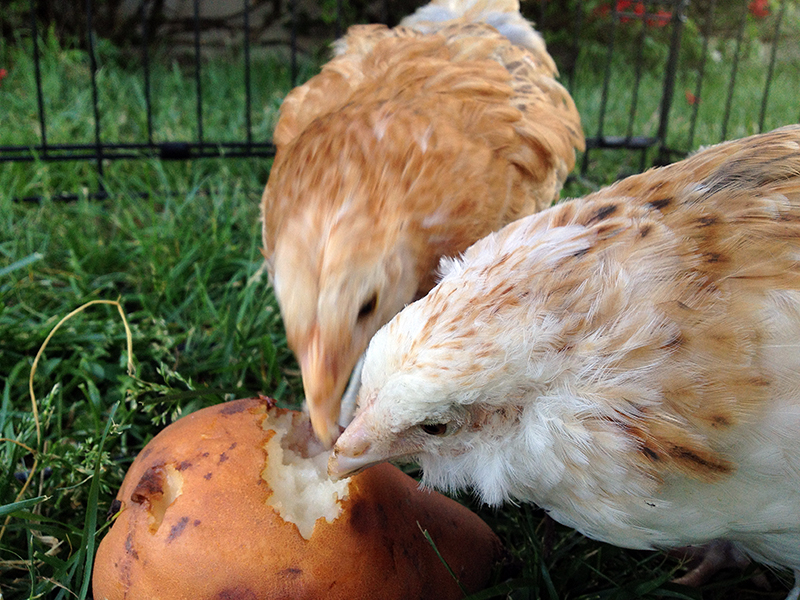

I am a bit sad that chick season is drawing to a close. If I could, I’d raise chickens all year long. I don’t think I will ever get tired of watching eggs turn into bright-eyed, beautiful birds.
Speaking of which, Mr. and Mrs. Bluebird are busy with their brood of four in the bluebird box. It’s wonderful to be back in bluebird season.

And finally, on a less joyful note, the feisty broody hen that hatched this latest batch of chicks wasn’t feisty enough when I returned her to the main flock. Despite holding her own for two days, on the eve of her third day back I found her with a quarter-size hole torn in the back of her skull. In her pain and panic to get away from her attackers she actually jumped into my arms from the nesting box. It’s the exact same wound Oregano sustained under similar circumstances, though this hen’s is worse.
She’s been getting daily Bactine spray and Neosporin plus Blue-Kote spray (which dyes her wound purple). I wish that I would have stitched her wound when I found it. She keeps knocking it open and it’s taking a very long time to heal, having to close from the outside in across basically her entire skull. In fact it’s larger now than it is in this photo, which I took a couple of weeks ago.

She doesn’t act hurt and has returned to laying eggs. As long as her wound doesn’t get infected I will just keep what I am doing and let it heal itself. My experience with Cora taught me that chickens can recover from the most dramatic wounds. This little hen is protected within another dog crate within the main coop, and will be until she heals and can successfully reintegrate with the flock.
This is what she gets for successfully raising the offspring of her sister flock mates. The injustice!
December 6th, 2013 §
Another olive egger pullet has come online. Yesterday I got two olive pullet eggs, and I figured out that their mother Dahlia is responsible for the big brown egg. She’s setting a good example!

These little olive eggs are so amazing. They’re like the eggs of some exotic species. And today I got one more! The pullets are twenty-one weeks old this week. Eventually the pullets should produce full-size eggs—these are just their starter eggs. Thus I am especially appreciating them because I know they are a fleeting phenomenon.
Something I never knew before I had chickens is that a hen will consistently lay eggs of basically the same shape and color, with the same amount of speckling. If you pay attention, this makes it easy to know which bird is laying which eggs, and how often, and gives you a good idea of a particular hen’s productivity. For example, I can tell from looking at the photo above that different pullets are laying the olive eggs, even if I didn’t know they were both laid on the same day, as one egg is browner with speckles, and the other is a clear, lighter olive. And the first egg I got this week was laid by the pullet that produces speckled olive eggs.
December 3rd, 2013 §
I had a completely unexpected surprise today as I was feeding the chickens. I glanced into their nest box and saw this:

Ever since the girls quit laying for the winter—many weeks ago—I’d stopped checking their nest box for eggs. But it turns out that even without any supplemental light, and headed into the darkest days of winter, at least two chickens are making an effort. One, laying the large brown egg, is either Dahlia or her Black Copper Marans sister. And the other laying chicken is a homegrown olive egger pullet, which is a total surprise as the chicks were born so late this summer that I hadn’t expected any of the four young pullets to lay before next spring.

This little olive pullet egg is the first egg from a chicken born and raised right here on Bonafide Farm. She’s a second-generation Bonafide bird, and a science experiment begun two years ago when I raised her Wheaten Ameraucana (blue egg-laying) and Black Copper Marans (dark brown egg-laying) parents with the hope that their genes would combine to produce a chicken that lays an olive egg.
And today, with this first beautiful olive pullet egg, I can claim success. Well, as much as one can having not actually laid the egg myself!
For more on how this pullet came to be, head on back to July 2013…
September 3rd, 2013 §
What happened to those damp little fuzzballs? Nothing remains of the chicks but their little peeping noises, which they still make when they aren’t busy practicing being grown-ups, crowing, and mating their siblings.
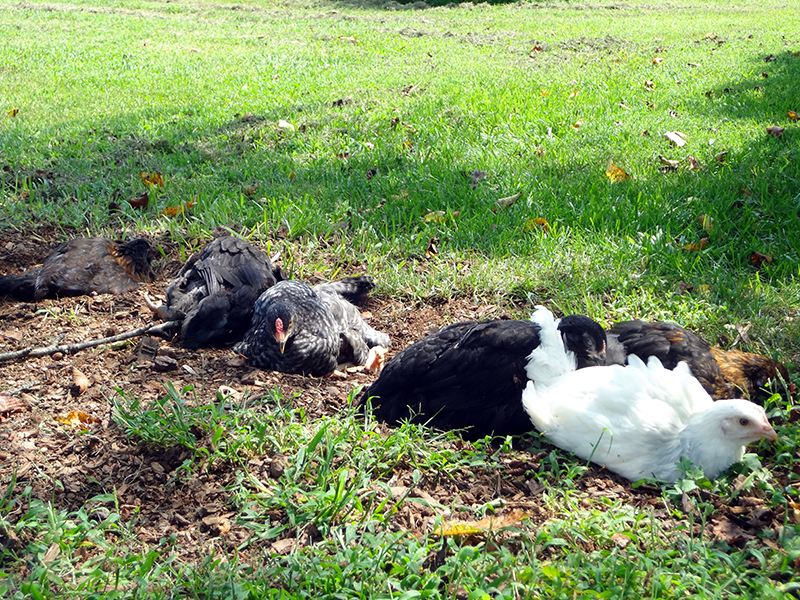
The chicks are now eight weeks old, and they are miniature chickens in most regards. This week I’ve let them find their own way out of their brooder coop and out of the garage into the wild world. They stick close to the bushes, dust bathing for hours in mulch, but each day they venture a bit further from their comfort zone. It’s wonderful to watch.
It looks like I have two cockerels: Griz, Oregano’s baby, and a Black Copper Marans/Wheaten Ameraucana mix. One thing I’ve really noticed is how much more flighty the chicks with the Black Copper Marans blood are. Makes sense, as their parent hens are the least docile of all my birds. Here’s the BCM/Wheaten Ameraucana cockerel, in front, with Griz behind, then the pretty black pullet hatched from Lilac’s egg, and finally a BCM/Wheaten Ameraucana pullet in back.
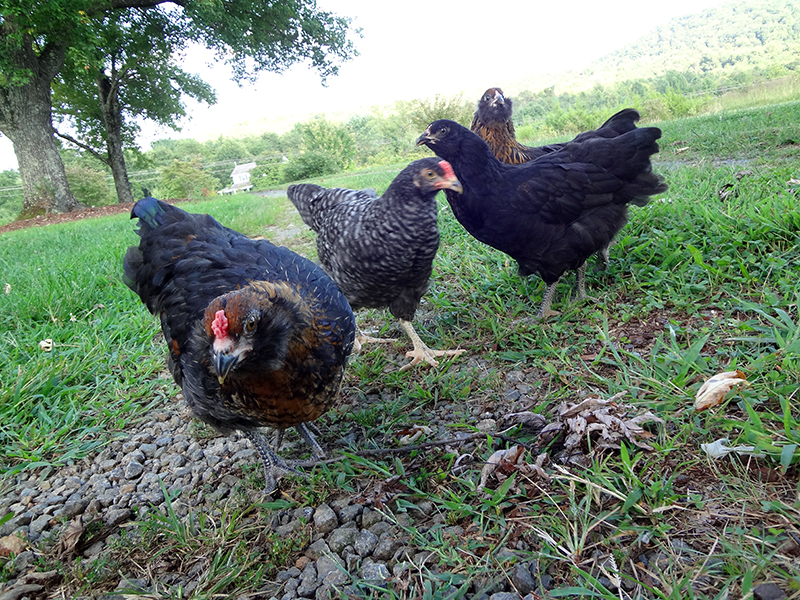
The homegrown birds all, except for Griz, have the cute facial feather tufting that comes along with their Wheaten Ameraucana blood. Interestingly, even though Griz’s father is a Wheaten Ameraucaua, he does not exhibit this feathering. Instead he looks like a straight-up Cuckoo Marans, which is blood that came from his mother’s line. So interesting to see genetics in action. Meanwhile, Griz learns just how palatable slippers are.
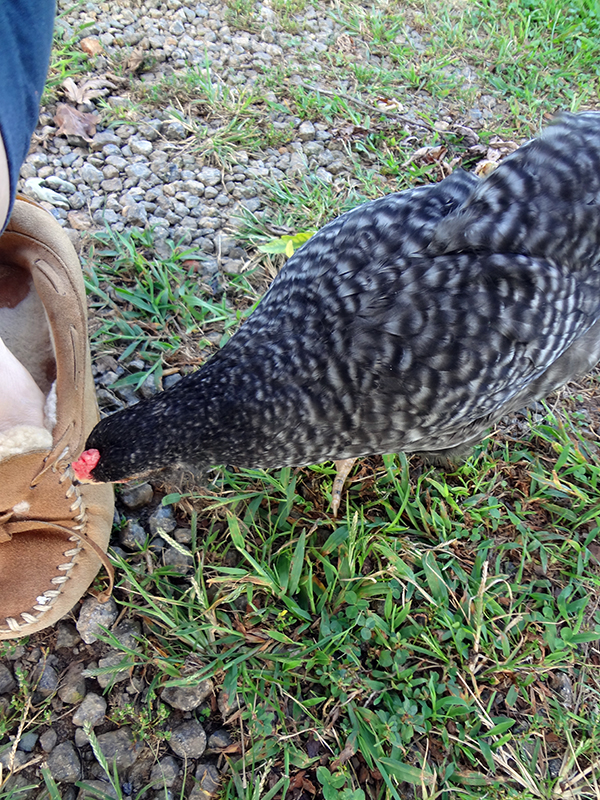
The white Coronation Sussex chick is, I believe, a pullet. Thank goodness. She is the sweetest of all six babies, always the first out of the coop and very amenable to being handled. Her lavender feathers are growing in around her head and tail, and I think she’s just so pretty. I have named her Calla.
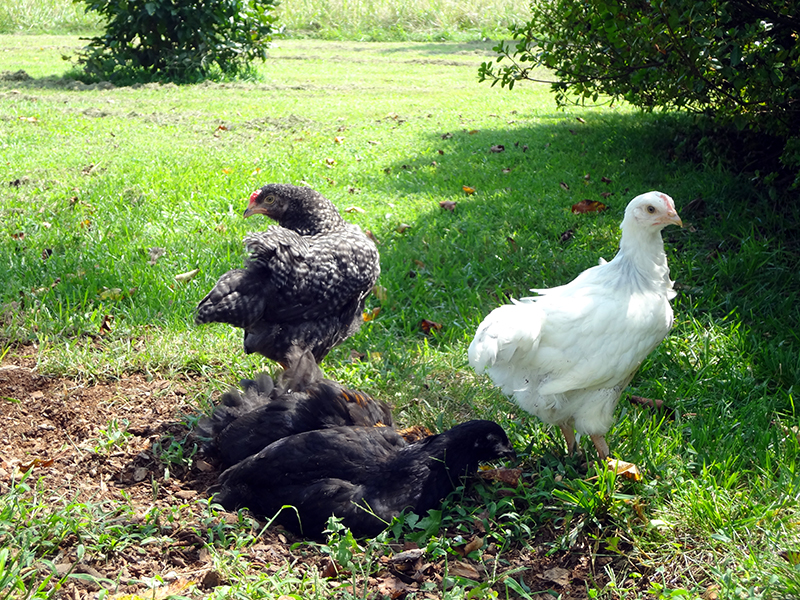
None of the other birds are named yet. I will have to see what comes to me. I also have to get Griz and the other young cockerel up on CraigsList soon. Hard to do because the birds are so cute right now—just perfect little mini chickens. But mini chickens will soon be full-blown roosters, and three on this farm is two too many.
The big chickens have met and mingled with the chicks. It’s gone okay, with the expected bullying as the older birds show the younger birds their place. Here’s Cora landing a squawk-inducing peck on a chick, while the other babies bunch up for safety and Griz tries to decide whether to be a man.

As of last night, Dahlia has rejoined her flock. It seems to be going okay for her. I bet she’s glad to be rid of these increasingly active babies in a small brooder coop.
Fifteen birds running around here is a lot, but I kind of love it. If chickens weren’t so messy, and their food so expensive, and if we didn’t have to go through winter when free-ranging isn’t as easy or safe, I would have zillions of chickens.
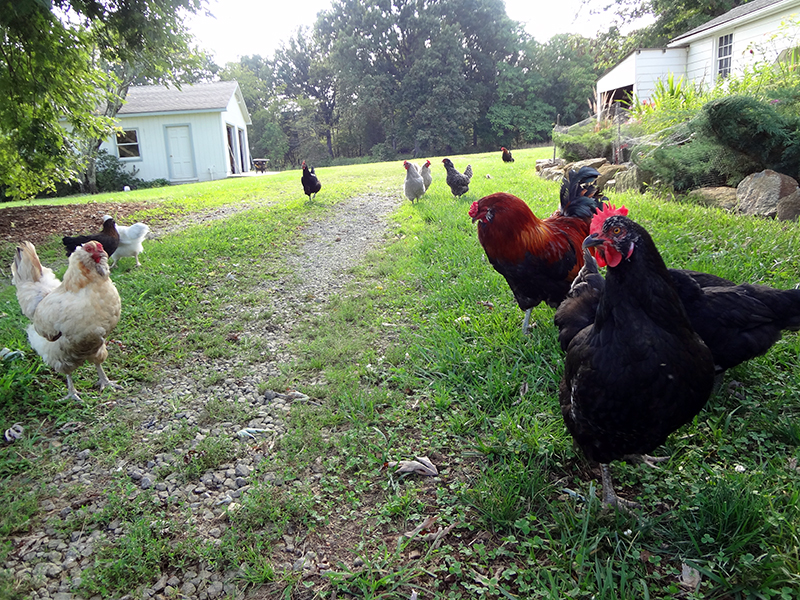
June 17th, 2013 §
Ever since April I’ve been hoping one of my hens would go broody and hatch some chicks. Why? Because baby chicks are some of the things that make life worth living, of course. That and I am seriously curious to see what kind of crosses would result from my Wheaten Ameraucana rooster over Black Copper Marans, Lavender Orpingtons, a Barred Olive Egger, and whatever mix Lilac and Iris are (Black Australorps and Mottled Java, according to their breeder).* Iris and Lilac are in their second year of lay, and it’s good to have younger pullets coming along to take over egg-laying duties. And finally, now that I am free-ranging the birds outside most days, I anticipate that at some point I will have predator loss and don’t want to be caught out with not enough laying hens to keep eggs in the fridge.
A broody hen is a wonderful creature because she manages all the care, feeding, and warming of young chicks. If you have ever raised chicks, you know that it’s a big, messy job to monitor their brooder temperature, clean up after them, keep them safe from drafts and predators, and make sure they get enough to drink and eat. So I told myself that the only way I would raise chicks this year was if a hen did all the work for me!
Last year Iris went unbreakably broody and I ended up giving her a clutch of fertile guinea eggs. She brooded them in a dog crate in the garage and hatched out and raised nine guineas. Here’s one at several weeks old, posing for its CraigsList portrait:
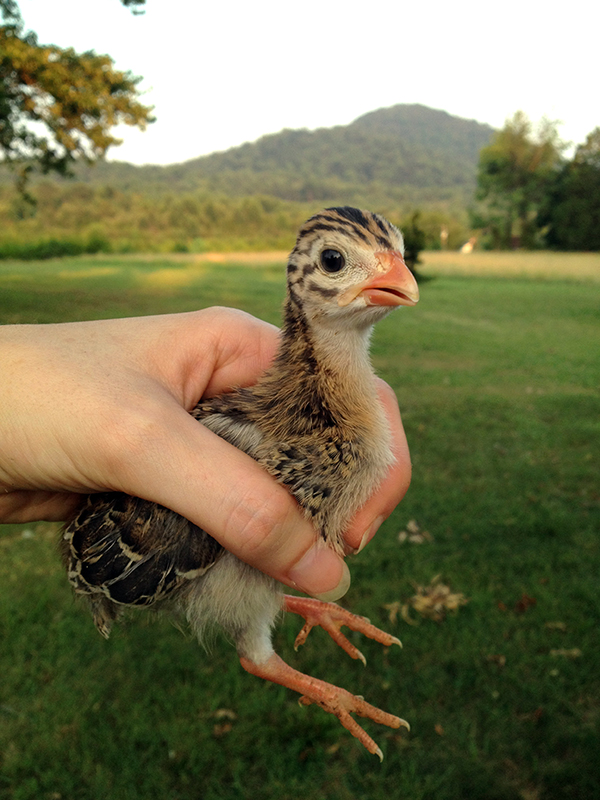
I got to watch the hatch and meet the still-damp keets, and it was one of the neatest days of my life. But this year, Iris has chosen to not do it again. Being trapped in a small cage with nine flighty, frantic, velociraptor-looking guinea keets was probably enough for her to sign off on motherhood forever. Not that I blame her—check out how those ravenous minidinosaurs are eying up their adopted mother’s toes while Iris pleads with her eyes for a Calgon moment.
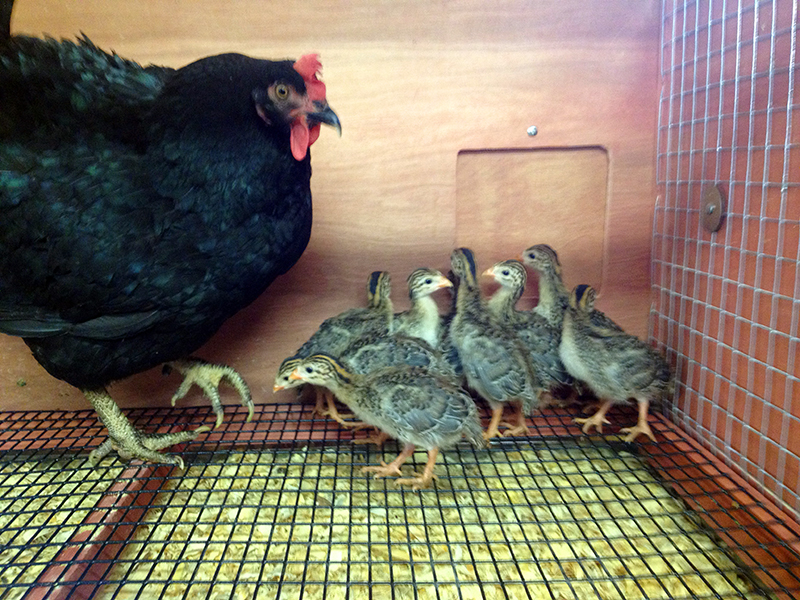
The most time-tested way to induce broodiness in a hen is to let eggs accumulate in the nest box. When the hen feels a growing clutch beneath her, some hormone switches in her brain that tells her to buckle down and brood. She will remain on the nest, barely eating and drinking, and will often pull feathers out of her breast so that she can keep the eggs tucked right next to her bare skin.
For weeks now I’ve been letting eggs accumulate, rotating out the older ones after a day or two in order to keep some in the fridge. I also placed the infamous glass eggs in the nests to trick the hens in to thinking there were always eggs waiting for a mother. And finally, it started to look like a few of then hens were beginning to feel broody.
Oregano, my beautiful barred olive egger, was the first to show any sort of devotion. After she’d been on the nest about a week, I fixed up a broody coop in the garage and built her a cardboard brood nest. It’s best to have a hen incubate eggs and raise chicks in a quiet, private place away from the bustle of the main coop, where flock mates may see new babies as tasty hors d’oeuvres. I was waiting for nightfall to move her to her new home when one of my Black Copper Marans saw the nest was exposed and jumped up to sit on the eggs.
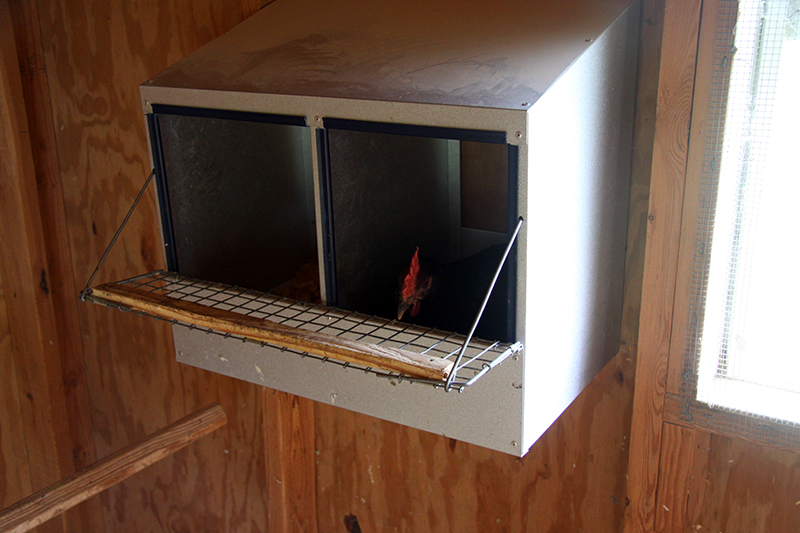
After dark, when I went to collect Oregano, the Black Copper Marans was still sitting tight on the eggs. One look and I got her message: She wanted a clutch of her own.
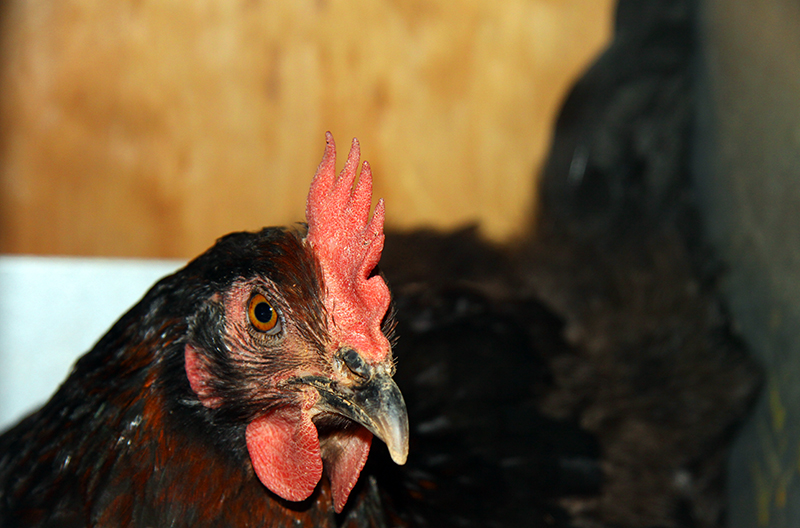
Oregano had assumed a broody position in the adjoining nest box. So I grabbed her and moved her and the eggs into the garage coop.
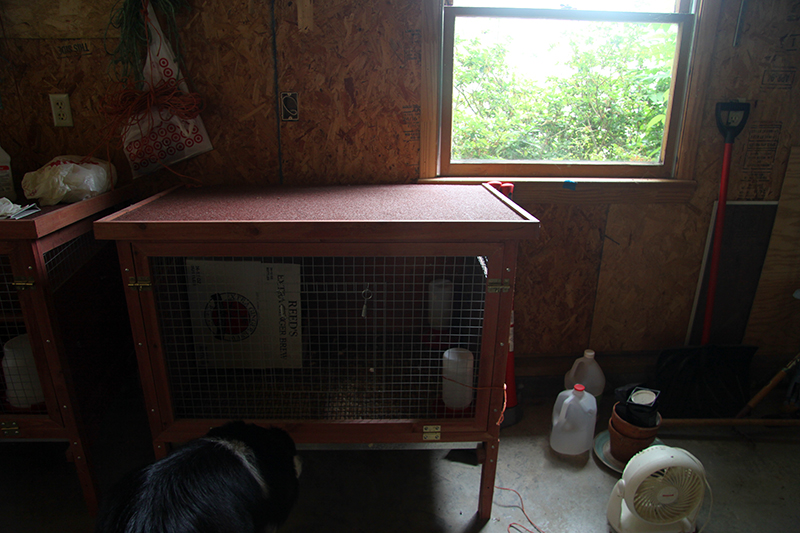
Oregano accepted her new nest and has stayed on it since Friday.
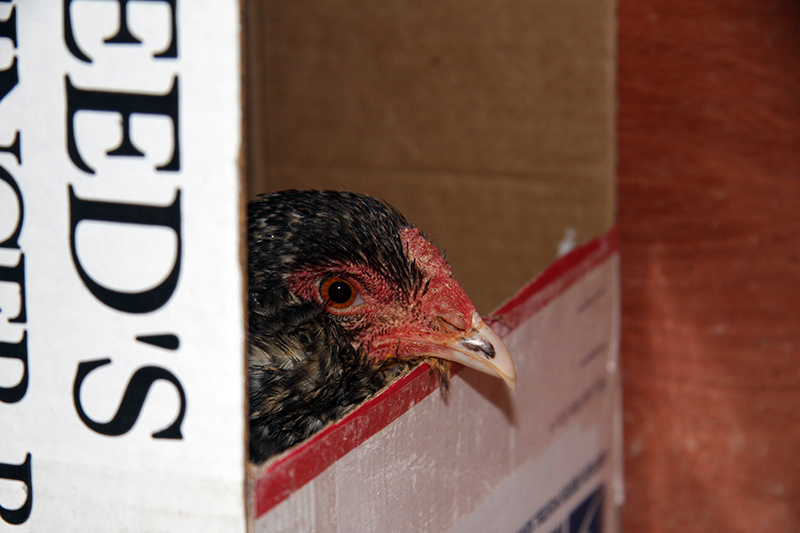
But the Black Copper Marans was still sitting on the glass eggs. And so I fixed up a second broody coop in the garage, built another cardboard next box, and last night moved her into a brood cage next to Oregano. So now I have two broody hens.
I have been saving out eggs for a week or so now, and when I get numbers I am satisfied with I will remove the glass and sacrificial eggs from under the hens and replace them with these fresh eggs. That way all embryos will start to develop at once, and all chicks will hatch at the same time. It’s a bit sad as the eggs are developing under Oregano, but their job really is to just “hold” the hen in a broody mindset until the more valuable eggs are introduced.
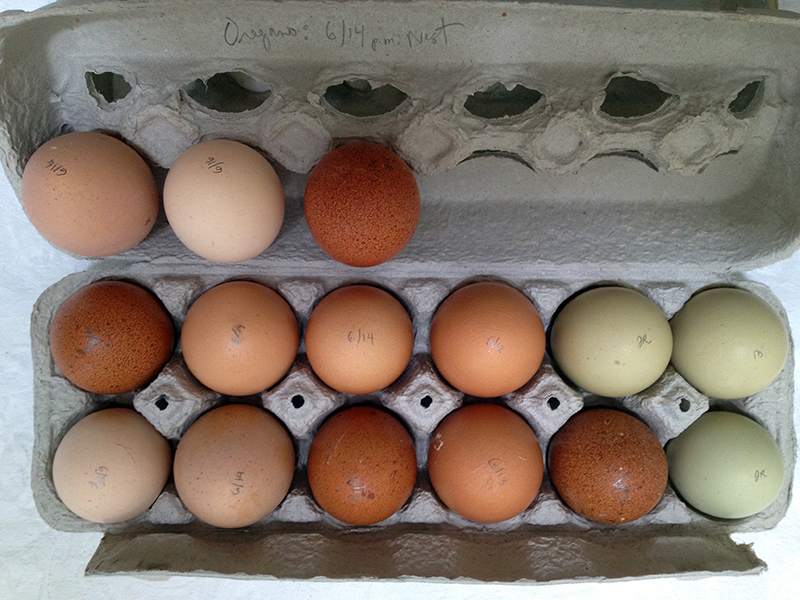
I wasn’t really planning on trying to raise two clutches, but at the end of the day it’s not such a bad thing. It means I can hatch more eggs, which is good as there is no way of knowing what the fertility rate is amongst my hens’ eggs. And, if one of the hens begins incubating and gives up, I could move the most valuable eggs to the other hen and have her take over. Thus, I am waiting until the same night to give both hens their eggs, and then we will see what happens! There is still a lot that can go wrong in the 21 days it takes to cook a chick, but I am having fun working with my broodies. If you’d like to know more, allow me to refer you to this excellent article by my favorite author on all things chicken, Harvey Ussery: Working with Broody Hens.
*A quick digression on chicken breeds and egg color: I have the right set-up to produce olive eggers, which, as their name suggests, lay olive colored eggs. To make a nice olive egger, you need a dark brown egg-laying breed (such as Black Copper Marans) mixed with a blue egg laying breed (Wheaten Ameraucana—my rooster). My Black Copper Marans don’t lay very dark eggs and I have no idea what sort of blue egg genetics my rooster carries, so I don’t suspect I will break any records with any pullets I hatch from that combination. But at the very least, I should end up with some sort of green egg, which is plenty exciting to me.
Now here is where it gets interesting. I have three eggs saved out from Oregano, my barred olive egger (the green eggs in the photo above). She does lay a very nice olive-colored egg, when she lays. By crossing her with Calabrese, and his blue egg genes, I may end up with a pullet that lays a really green egg, as opposed to an olive egg. But who knows, really? I have read about chicken genetics until I fell over from confusion and still am not sure what will happen. Mostly because I know nothing about the genetics of the birds I am starting with, other than their supposed breeds and what color eggs the hens lay now. And there’s always the possibility that I will hatch 100% cockerels and then the whole experiment is good for nothing but the freezer. And even if I do hatch pullets, it will be another year until they lay and who knows if I will even be in to chickens then!
November 26th, 2012 §

On November 8, Cora laid her first perfect blue egg. This was a discovery of pure joy as Cora—my only Wheaten Ameraucana pullet— survived a vicious attack in her young life and walked so close to death for several months as her scalped head healed.

The Black Copper Marans have also started laying (darkest brown eggs above), as well as the Lavender Orpingtons (light-toned eggs above). Lilac and Iris still seem to be keeping up in their second year of laying. The light on a timer set to turn on at 5:00 a.m. seems to be doing the trick to foil the low-daylight hour laying slowdown. My record has been seven eggs in one day, which of a flock of eight hens is a pretty good return. I am not sure that my “barred olive egger” Oregano has laid yet—if she has, she’s not an olive egger!
One of the best parts of my day is picking up the eggs. It’s this pleasure that exists to offset the pain of discovering and nursing bleeding mostly dead birds, managing flock integration, mucking out the coop, and all the other rough aspects of being mother hen.

Recovered, and now productive, Cora, with only a slightly mussed feather pattern about her beautiful head to belie her hard young life.
October 8th, 2012 §
One of my lavender orpington pullets came online today and laid her first egg. That extra light in the morning must be working. Here’s her egg on the right, next to Iris’s daily contribution. Not bad for a pullet egg—and she even managed to get it in the nest box! I am excited to see the other young hens start to contribute to the daily egg count.
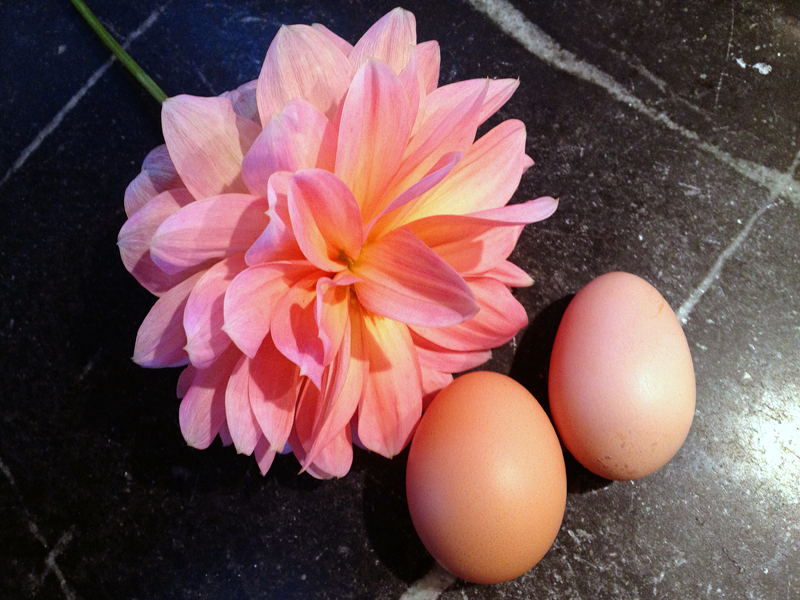
In other news, I ran out to the garage this evening—in my slippers—to retrieve something from the car. On my way out I looked down and saw this:

Looks like I’d smashed this black widow on the floor! That’s pretty close for comfort…weird too as last Friday night I dreamed I was bitten by something on my foot, I saw two marks and dream-assumed it was a snake bite but maybe it was a spider warning!
If you had any doubt, I flipped this lady over to show her identifying red hourglass. She was pretty good-sized!

Tonight’s our first taste of the coming winter. It’s in the low 40s and grey and rainy. My house is about 63 degrees without the central heat yet on and I am eying the woodstove with longing. Too many other things to do tonight to get involved with the first fire of the season, so that will have to wait and in the meantime I am in triple layers of wool and sheepskin. Plus, it’s supposed to return to the 70s later this week!































